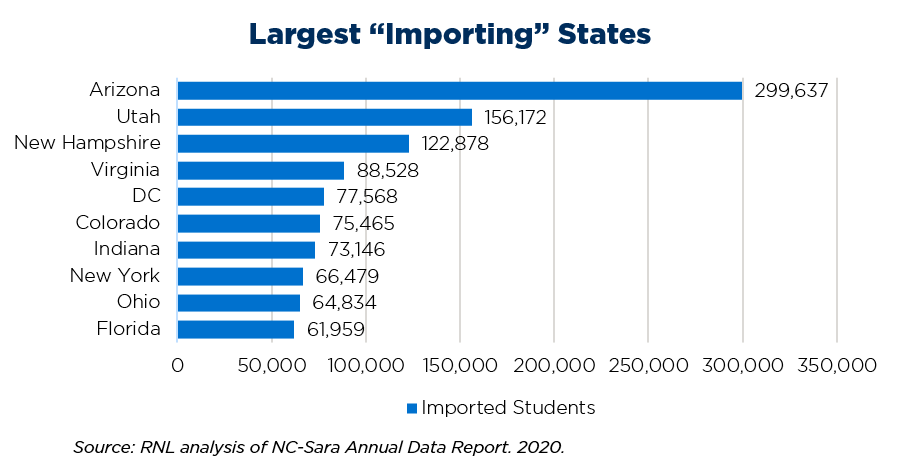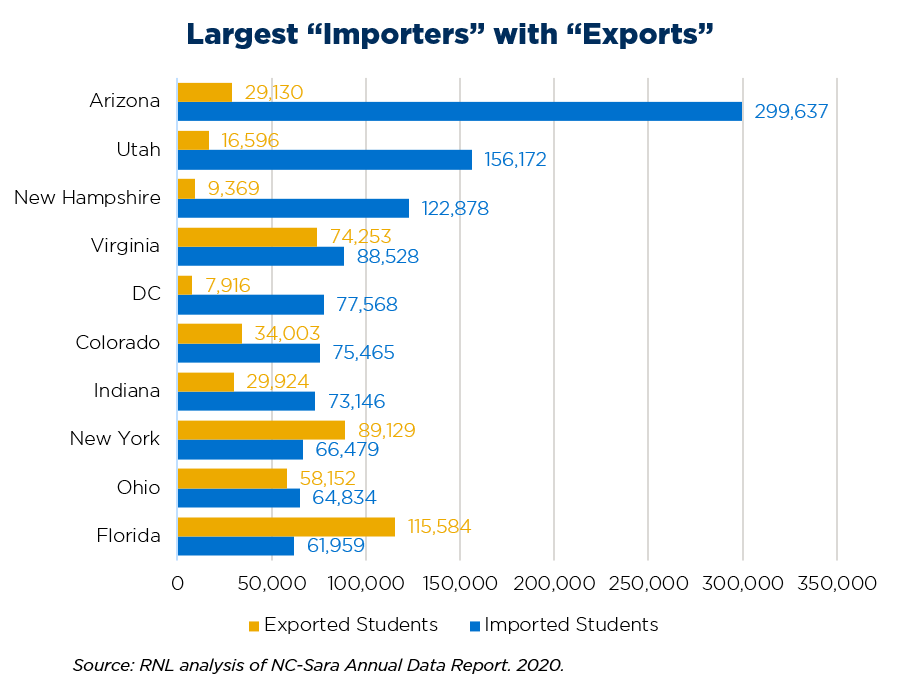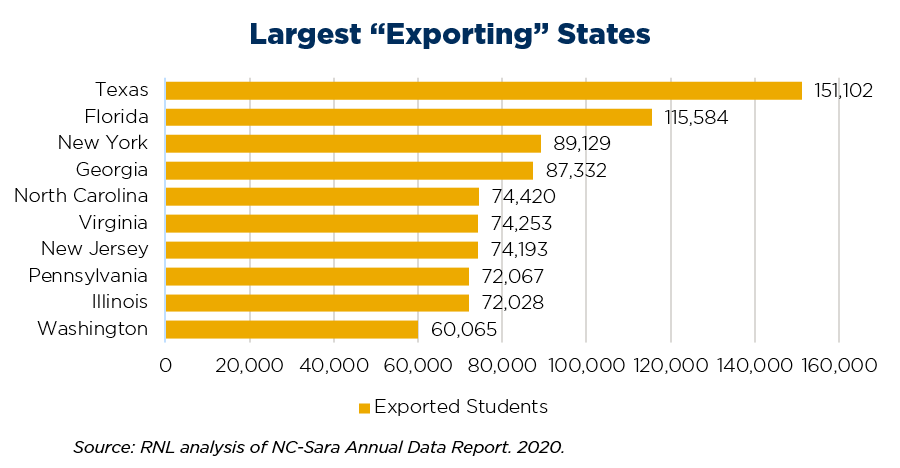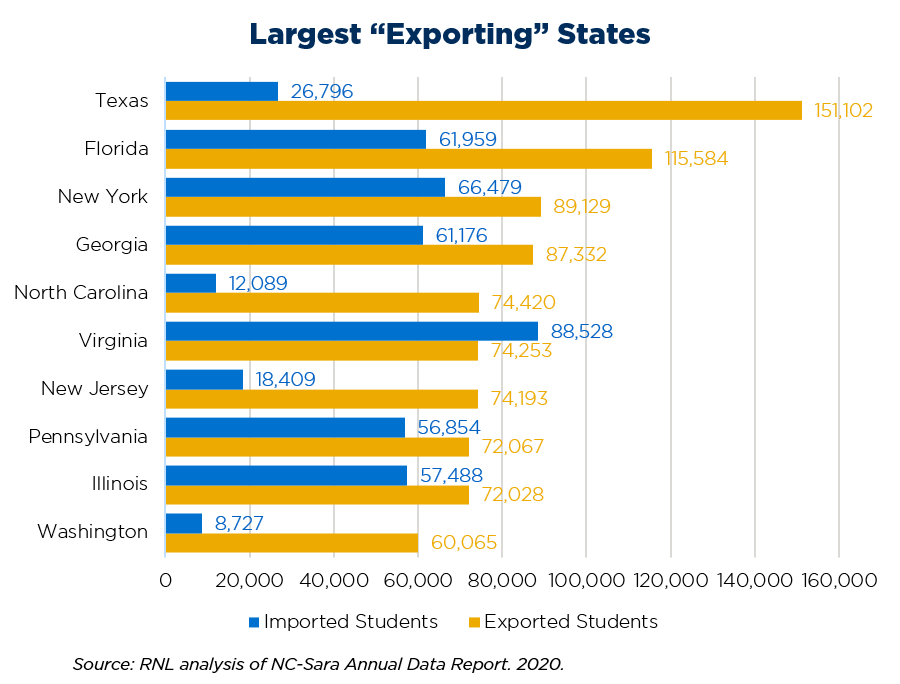enrollment
Is Your State Exporting Online Students to Other States?
As online and hybrid programs have grown over the last decade options and opportunities for students and institutions alike have also multiplied. The pandemic has also forced millions more students to try online, likely triggering the “Mikey effect” of “try it, you’ll like it.” Exclusively Distance Education enrollment (EDE enrollment in NC-Sara parlance) nearly doubled (rising 93 percent) between the fall semesters of 2019 and 2020. This has the potential to expand online higher education in ways we could not have predicted just 24 months ago.
Online students can enroll anywhere as long as there is a program that interests them. This, combined with RNL’s recent research indicating that the most important factor in choosing a program is a “match between my interests and program content” has the potential to change the enrollment trajectories for states that do not have sufficient online program offerings, do not have online program offerings in subjects in high demand, or do not offer online programs in a manner that is conducive to how online students want to study (RNL’s 2022 study on the demands and preferences of online students will address all of these issues.)
NC-Sara’s 2020 Annual Data Report showcases many aspects of their work, but we were most interested in what we are referring to the “importing and exporting” of students across state lines. These data first came into focus when a president asked me it we would figure out where “his” prospective online students were going (his online programs are under-enrolled). While we can’t figure out exactly where “his” students were going, we could understand the extent to which students from his state are enrolling in online programs in other states—and more importantly at which institutions (as long as they report to NC-Sara).
Largest “importers” of online students
In 2020, the states that attracted (“imported”) the largest numbers of students to online programs at institutions in their states were Arizona (299,637), Utah (156,172), New Hampshire (122,878), Virginia (88,528), and District of Columbia (77,568).

The first three of these states are the home state of several of the largest online institutions in the nation (University of Phoenix, Grand Canyon University, Arizona State, Southern New Hampshire University, Western Governors University, and Liberty University), but DC’s positive situation is being driven by other factors. Among the five additional states comprising the 10 largest importers, only Indiana (home of Purdue Global) has a single dominant online institution known to have a national draw.
Most of these states are in a strong position in terms of the number of “imported” students exceeding the numbers of students they are losing to other states (“exporting”). The four states with national online institutions (Arizona, New Hampshire, Utah, and Indiana) have the strongest positive balance, but several of the states with no single mammoth institution (Virginia, New York, Ohio, and Florida) are in far less a dominant position, with both New York and Florida exporting more online students than they are importing. In fact, Florida exports almost twice as many online students than it imports.

Largest “Exporters”
The states that lost (“exported”) the most students to online programs in other states were Texas (151,102), Florida (115,584), New York (89,129), Georgia (87,332), and North Carolina (74,420).

It is noteworthy that none of these states includes a single institution that is among the largest online institutions in the nation.

When you layer in the students that each state is attracting from other states (“imported students), you see that Texas, North Carolina, New Jersey, and Washington (state) are in particularly disadvantageous positions. Not only are they exporting massive numbers of students to online programs in other states, they are also not attracting students to their programs. In fact, these four states—and Florida—comprise the five states with the greatest imbalances of online students. (NC-Sara provides data as an appendix to their report that provides insight at both the state level and institution level on where students are going to and coming from).
Where are online students enrolling?
There are a few institutions that are almost completely responsible for their state’s importing of students. Western Governors University, Southern New Hampshire University, University of Phoenix, Grand Canyon University, and Liberty University are amongst the largest of these online institutions that are importing large numbers of students. Western Governors University, located in Utah, is a prime example of this (single-handedly responsible for most online enrollment in Utah). With a total enrollment of 147,177, we see that they enroll 15,447 from Texas, 7,585 from Florida, 4,198 from North Carolina, 3,995 from Virginia, and 1,696from New Jersey.
This is just one of the many institutions that are contributing to the challenges of each of these states. It is also important to note that most out-of-state enrollment is in the private (for-profit/nonprofit) sector;publicinstitutions reported 85.3 percent in-state enrollment.
How can this be fixed?
Why are students in some states deciding in such large numbers to enroll in programs outside their home state? It is highly likely that their decisions are affected by several of the factors identified about online students in RNL’s 2021 Graduate Student Recruitment Report:
- They enroll in programs that are the closest match to their specific interests.
- They are acutely concerned about employment prospects and look for such information on program websites.
- They expect speedy response to their inquiries (more than 60 percent expect a response within an hour).
- They will enroll in the first program that admits them more than 80 percent of the time.
Each of these factors will be addressed in extensive detail in RNL’s forthcoming Online Student Recruitment Report, which will be published in March, 2022.
Jacob Davidson, market research graduate intern, contributed to the research and writing of this blog.
Find the optimal online enrollment strategy
Talk with RNL’s online enrollment experts about finding the right strategy for your institutions and programs. We can discuss research, digital lead generation, online curriculum enablement, and more.
